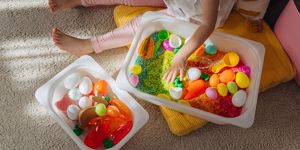Looking for sensory crafts and sensory activities to do with the kids?
Well, I'm not gonna lie... crafts are not my favourite thing to do. Neither is the clean-up that comes directly after crafting. "Let's open the craft cupboard!" is in the top five of the most dreaded things our kids say… they LOVE getting crafty, And who are we to stop them?
There comes a point where you have to embrace the crafts. I don't mind admitting that after six years of finding new and exciting ways to entertain the kids on rainy days, I've got a few easy ideas worth sharing. Buckle up and get ready to dive into a world of sensory play where all your child's senses come alive! We're talking about engaging touch, smell, sight, sound, taste, movement, balance, and spatial awareness. These activities are a full-on sensory extravaganza for your little one's curious mind and growing body!
All you need to do is fill a shallow container with various materials like rice, pasta, water beads, or sand. Add small toys, spoons, cups, or measuring scoops to encourage exploration and tactile stimulation. Let your little one dig in, scoop, pour, and discover the different textures. What's great about sensory bins is that they're easy to mix up and try new things. The different materials and objects inside provide opportunities for sensory exploration, helping kids learn about textures, weights, and temperatures.
Sensory bins also spark imagination and creativity, as children can engage in pretend play and storytelling within these exciting sensory landscapes. They encourage language development, social skills, and problem-solving as children interact with the materials and share the experience with others.
Creating your very own sensory box at home gives you a great go-to to keep your little ones engaged and learning.
Creating a sensory bottle is a breeze! Grab a clear plastic bottle with a secure lid. Fill it with a captivating combination of materials like colourful beads, glitter, sequins, or small toys. Add water or clear glue to the bottle, leaving some space at the top for movement. Seal the lid tightly and give it a good shake to see the magic come to life. Encourage your little ones to explore the sensory wonderland by rolling, flipping, and observing the mesmerising contents.
Top Tip: remember to make sure the bottle is properly sealed to avoid spillages, and if they're really little, supervise them!
Play-Doh from Amazon was just the ticket for us and still is. Both playdough and kinetic sand are a hot fave in our house, even now when the kids are four and six years old. Kids (and adults, to be fair) love squishing, molding and playing with soft, textured dough. Kinetic sand isn't as bad as you think it might be.... unless you have carpets.
If you do want to make your own playdough, apparently, it's pretty easy. My mum used to make it with flour, salt, water, and food colouring. You can add different scents, like vanilla, for an extra special sensory touch.
Investing in non-toxic, washable paints is essential with little ones, so they can get messy without worry. It'll also make clean-up slightly easier. Let them release their inner Kandinsky and explore colours and textures by smearing, spreading and creating their very own beautiful fingerprint and handprint masterpieces. I love seeing what the kids create. We've framed a fair few of their pics.
Cut out different shapes or let your child tear the materials and create a sensory collage by glueing them onto cardboard or thick paper. This activity is great for touch and visual senses, as well as their fine motor skills, if they're old enough to use a safe pair of scissors.
Fill a shallow container with water and add items like rubber ducks, sponges, measuring cups, and bath toys. Let your child splash, pour, and play with the water, engaging their sense of touch, sight, and sound. If it's summer, you can play outside in the shade and save your house getting soaked (which, of course, it will do). When they're older, they'll love to help you wash up, and when they're teeny tiny, join them in the bath and have some fun!
Well, I'm not gonna lie... crafts are not my favourite thing to do. Neither is the clean-up that comes directly after crafting. "Let's open the craft cupboard!" is in the top five of the most dreaded things our kids say… they LOVE getting crafty, And who are we to stop them?
There comes a point where you have to embrace the crafts. I don't mind admitting that after six years of finding new and exciting ways to entertain the kids on rainy days, I've got a few easy ideas worth sharing. Buckle up and get ready to dive into a world of sensory play where all your child's senses come alive! We're talking about engaging touch, smell, sight, sound, taste, movement, balance, and spatial awareness. These activities are a full-on sensory extravaganza for your little one's curious mind and growing body!
Sensory Boxes
Get ready for some hands-on, sensory-filled fun with a sensory box - or, as they're sometimes called, sensory bins. These nifty play setups allow children to explore, learn, and engage their senses in a whole new way. Kids will love to dive into a box filled with different textures, colours, and objects. They can scoop, pour, and dig their little hands through the materials. They'll have a blast AND be working on some fundamental skills. Sensory bins are super versatile and can support various types of development.All you need to do is fill a shallow container with various materials like rice, pasta, water beads, or sand. Add small toys, spoons, cups, or measuring scoops to encourage exploration and tactile stimulation. Let your little one dig in, scoop, pour, and discover the different textures. What's great about sensory bins is that they're easy to mix up and try new things. The different materials and objects inside provide opportunities for sensory exploration, helping kids learn about textures, weights, and temperatures.
Sensory bins also spark imagination and creativity, as children can engage in pretend play and storytelling within these exciting sensory landscapes. They encourage language development, social skills, and problem-solving as children interact with the materials and share the experience with others.
Creating your very own sensory box at home gives you a great go-to to keep your little ones engaged and learning.
Sponsored By: Center Parcs
Win A Family Break At Center Parcs
Your Baby Club and Center Parcs are giving you a chance to win a family break in a Woodland Lodge at a UK Center Parcs village of your choice.
Your Baby Club and Center Parcs are giving you a chance to win a family break in a Woodland Lodge at a UK Center Parcs village of your choice.
Sensory Bottles
Welcome to the magic of sensory bottles! These captivating creations are great for igniting wonder and curiosity in children as they engage their senses and offer various developmental benefits. They can enhance fine motor skills when kids participate in making them and boost language and social skills.Creating a sensory bottle is a breeze! Grab a clear plastic bottle with a secure lid. Fill it with a captivating combination of materials like colourful beads, glitter, sequins, or small toys. Add water or clear glue to the bottle, leaving some space at the top for movement. Seal the lid tightly and give it a good shake to see the magic come to life. Encourage your little ones to explore the sensory wonderland by rolling, flipping, and observing the mesmerising contents.
Top Tip: remember to make sure the bottle is properly sealed to avoid spillages, and if they're really little, supervise them!
Playdough or Kinetic Sand
Here's the bit where I should make a straight face and tell you to try making homemade playdough cos it's great fun, but as a full-time working mum, I've never actually made it. Sigh.Play-Doh from Amazon was just the ticket for us and still is. Both playdough and kinetic sand are a hot fave in our house, even now when the kids are four and six years old. Kids (and adults, to be fair) love squishing, molding and playing with soft, textured dough. Kinetic sand isn't as bad as you think it might be.... unless you have carpets.
If you do want to make your own playdough, apparently, it's pretty easy. My mum used to make it with flour, salt, water, and food colouring. You can add different scents, like vanilla, for an extra special sensory touch.
Finger Painting and Hand Printing
When it comes to painting of any kind, prepping your area is a must to avoid the hour-long clean-up. Paint gets EVERYWHERE. Buy a messy mat to protect your table, or get one of those wipe-clean tablecloths. If you're painting in a carpeted room, buy one of those protective floor sheets.Investing in non-toxic, washable paints is essential with little ones, so they can get messy without worry. It'll also make clean-up slightly easier. Let them release their inner Kandinsky and explore colours and textures by smearing, spreading and creating their very own beautiful fingerprint and handprint masterpieces. I love seeing what the kids create. We've framed a fair few of their pics.
Sensory Collages
Your craft box or cupboard must be on its A-game for this one. You'll need a variety of textured materials to make a sensory collage. Think tissue paper, fabric scraps, feathers, and foil.Cut out different shapes or let your child tear the materials and create a sensory collage by glueing them onto cardboard or thick paper. This activity is great for touch and visual senses, as well as their fine motor skills, if they're old enough to use a safe pair of scissors.
Sensory Busy Bags
Another easy peasy one! Fill a resealable plastic bag with different bits and bobs, such as cooked pasta, shredded paper, pom-poms, or even squishy gel pads. Seal the bags tightly and let your child squish, squeeze, and manipulate the contents for mess-free sensory fun!Sensory Water Play
Last but not least... Water play is a favourite with babies, toddlers and young children in general, and you can entertain them in lots of different ways.Fill a shallow container with water and add items like rubber ducks, sponges, measuring cups, and bath toys. Let your child splash, pour, and play with the water, engaging their sense of touch, sight, and sound. If it's summer, you can play outside in the shade and save your house getting soaked (which, of course, it will do). When they're older, they'll love to help you wash up, and when they're teeny tiny, join them in the bath and have some fun!
Articles shown are a mixture of informative pieces, anecdotal accounts and professional advice from our panel of Bloggers, Writers and Experts. The views and opinions expressed in these articles are those of the authors and do not necessarily reflect the official view of this site.







